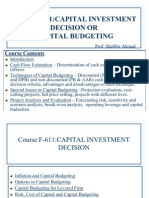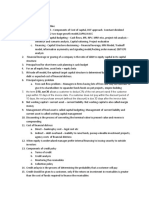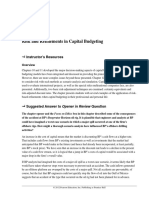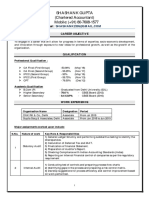Capital Budgeting Theories
Capital Budgeting Theories
Uploaded by
Abraham ChinCopyright:
Available Formats
Capital Budgeting Theories
Capital Budgeting Theories
Uploaded by
Abraham ChinOriginal Description:
Original Title
Copyright
Available Formats
Share this document
Did you find this document useful?
Is this content inappropriate?
Copyright:
Available Formats
Capital Budgeting Theories
Capital Budgeting Theories
Uploaded by
Abraham ChinCopyright:
Available Formats
Capital Budgeting
Capital Budgeting
- The process of choosing assets and the process of making capital expenditure decisions.
- The long term planning process of making and finacing investments that affects a company’s financial
results over a number of years.
Terms:
1)Mutually Exclusive Projects
- competing investment projects where accepting 1 project eliminates the possibility of taking the
other projects.
- if accepted, preclude the acceptance of competing projects.
2)Independent Projects
- A project when accepted or rejected will not affect the cash flows of another project.
3) Capital Investment Decision
- essentially a decision to exchange current cash outflows for the promise of receiving future
cash inflows.
4) Screening Decision
- deciding wheter or not an investment meets a predetermined company standard.
5) Net Present Value Method
- primary capital budgeting method that uses the discounted cash flow technique.
- assumes a reivested rate equal to the discount rate.
- indicated that a project is deemed desirable when it is greater than or equal to 0.
- assumes that intermediate cash inflows are reinvested at the minimum acceptable rate of
return.
6) Cost of Capital
- cost the company must incur to obtain its capital resources.
7) Sensitivity Analysis
- see how a decision would be affected by changes in variables.
- uses a number of outcome estimates to get a sense of the variability among potential returns.
- an appropriate response to uncertainty in cash flow projections.
Comprehensive Reviewer in MAS 2018 edition by Bobadilla and Trinidad
Handout of Abraham D. Chin
Capital Budgeting
8) Post Audit of Capital Projects
- provides a formal mechanism by which the company can determine whether existing projects
should be supported or terminated.
- A thorough evaluation of how well a project’s actual performance matches the projections
made when the project was proposed.
9)Periodic Cash flows associated with an investment project
- Savings in Taxes caused by deductibility of depreciation on tax return.
10)Total Project Approach
- Approach that computes the total impact of cash flows for each option and then converts the
total cash flows to their present value.
11) Payback Period
- technique that is least likely to be affected by an increase in the estimated residual value of
the projects.
- legth of time needed for a long term project to recapture its initial investment amount.
12) Payback Method
- technique that is most concerned with liquidity.
- assumes that all intermediate cash inflows reinvested to yield a return equal to 0.
- the least theoretically correct of all Capital Budgeting methods.
-Potential uses:
A) Help managers control the risks of estimating cash flows.
B) Help minimize the impact of the investment on liquidity.
C) Help control the risk of obsolescence.
13) Average Rate of retun method
- It emphasizes the amount of income earned over the life of the proposal.
14) Accelerated Methods
- used by managers to have as much depreciation in the early years of an asset’s life.
Comprehensive Reviewer in MAS 2018 edition by Bobadilla and Trinidad
Handout of Abraham D. Chin
Capital Budgeting
15) Internal Rate of return (IRR)
- when used as a discount rate, it equates the NPV of a series of cash flows to 0.
- assumes a reinvested rate equal to the internal rate of return.
- If this is 0, its annual cash flows equal to its required investment.
- produces a 0 NPV when a project’s discounted cash operating advantage is compared to its
discounted net investment.
16) Just in time approach
- when evaluating an investment that would reduce inventory with this approach, they should
decrease the cost of the investment.
17) Profitability Index
- allows comparison of the relative desirability of projects that require varying initial
investments.
- most helpful in preference decisions.
18) Out of the pocket costs
- cost that requires a future outlay of cash that is relevant one for future decision making.
Problems associated with justifying investments in high tech projects often include:
1) Discount rates that are too high
2) Time horizons that are too short.
In evaluating high tech projects:
- both tangible and intangible benfits should be considered.
Biggest challenge in the decision to purchase new equipment:
- estimating cash flows for the future.
Comprehensive Reviewer in MAS 2018 edition by Bobadilla and Trinidad
Handout of Abraham D. Chin
Capital Budgeting
Note:
1) The higher the risk element, the higher the discount rate required.
2) The normal methods of analyzing ivestments require forecastsof cash flows expected from
the project.
3) If a company gets a one year bank loan to help cover the initial financing of one of its capital
projects, the analysis should ignore the loan.
4) The only future costs that are relevant to deciding whether to accept an investment are those that
will be different if the project is accepted or rejected.
5) If a company uses IRR to evaluate long term decisions and establishes a cut off rate of return, the
cutoff rate is at least equal to its cost of capital.
6) How projects are listed in their order of increasing risk:
- Replacement, Expansion, New Venture.
7) Investment in working capital is non tax deductible
Investment in depreciable assets does allow tax deductions.
8) NPV and IRR both give the same decision ( accept or reject) for any single investment.
9) Depreciation is a cash flows but does not affect the tax cash flow.
10) If there are no income taxes, depreciation would be ignored.
11) If company’s required rate of return is 12% and in using the profitability index method, the project
is greater than 1, this indicates that the project rate of return is MORE THAN 12%.
12) The rHighe the cost of capital, the lower the net present value.
13) A payback period of less than 50% the life of a project will yield an IRR lower than the target rate.
14) Manager should always choose mutually exclusive investments with the highest NPV.
15) If the porject’s payback period is greater than its expected useful life, the entire initial investment
will not be recovered.
16) An increase in the discount rate would decrease the net present value of a project.
Comprehensive Reviewer in MAS 2018 edition by Bobadilla and Trinidad
Handout of Abraham D. Chin
You might also like
- Week 1 - EViews Practice NoteDocument8 pagesWeek 1 - EViews Practice NoteChip choiNo ratings yet
- CH 10.risk and Refinements in Capital BudgetingDocument27 pagesCH 10.risk and Refinements in Capital BudgetingTria_Octaviant_8507100% (1)
- Chapter 2 - Taxes, Tax Laws, and Tax AdministrationDocument12 pagesChapter 2 - Taxes, Tax Laws, and Tax AdministrationAbraham Chin100% (3)
- Tuscan Lifestyles Case SummaryDocument2 pagesTuscan Lifestyles Case SummaryAUNG100% (1)
- Chapter 6 - The Analysis of Investment ProjectsDocument16 pagesChapter 6 - The Analysis of Investment ProjectsAbdul Fattaah Bakhsh 1837065No ratings yet
- Assignment - Capital BudgetingDocument9 pagesAssignment - Capital BudgetingSahid KarimbanakkalNo ratings yet
- Case 11Document10 pagesCase 11Trương Quốc VũNo ratings yet
- D.5.1 2017 SGV Audit Engagement LetterDocument7 pagesD.5.1 2017 SGV Audit Engagement LetterAbraham ChinNo ratings yet
- Capital Bud GettingDocument27 pagesCapital Bud Gettingcindysia000No ratings yet
- Chap 4 CDocument33 pagesChap 4 CHiwot AderaNo ratings yet
- 22 Capital Rationing and Criteria For Investment AnalysisDocument10 pages22 Capital Rationing and Criteria For Investment AnalysisManishKumarRoasanNo ratings yet
- Methods of Project AppraisalDocument28 pagesMethods of Project AppraisalMîñåk ŞhïïNo ratings yet
- Capital BudgetingDocument16 pagesCapital Budgetingrahul9288100% (7)
- Sec e - Cma Part 2Document4 pagesSec e - Cma Part 2shreemant muniNo ratings yet
- Net Present Value Method Net Present Value Method (Also Known As Discounted Cash Flow Method) Is A PopularDocument15 pagesNet Present Value Method Net Present Value Method (Also Known As Discounted Cash Flow Method) Is A PopularImranNo ratings yet
- International Capital Burgeting AssignmentDocument18 pagesInternational Capital Burgeting AssignmentHitesh Kumar100% (1)
- Definitions in Multinational Capital BudgetingDocument9 pagesDefinitions in Multinational Capital BudgetingnehaNo ratings yet
- L1R32 Annotated CalculatorDocument33 pagesL1R32 Annotated CalculatorAlex PaulNo ratings yet
- Capital BudgetingDocument6 pagesCapital BudgetingHannahbea LindoNo ratings yet
- Cap Bud ProbDocument9 pagesCap Bud ProbJulie Mark JocsonNo ratings yet
- CAPITAL BUDGETINGDocument9 pagesCAPITAL BUDGETINGnavinNo ratings yet
- A. The Importance of Capital BudgetingDocument34 pagesA. The Importance of Capital BudgetingMutevu SteveNo ratings yet
- Finance Midterm QuestionsDocument3 pagesFinance Midterm QuestionsAnonymous x4LL5ecNCRNo ratings yet
- 1Document2 pages1farhanbaryarNo ratings yet
- Unit I Part 2Document32 pagesUnit I Part 2Gowri RamachandranNo ratings yet
- 20 FM PPPDocument17 pages20 FM PPPvivek.blyNo ratings yet
- Gitman 12e 525314 IM ch10rDocument27 pagesGitman 12e 525314 IM ch10rSadaf ZiaNo ratings yet
- Cid IntropptDocument42 pagesCid IntropptSaira BanuNo ratings yet
- Case Study RevisedDocument7 pagesCase Study Revisedbhardwaj_manish44100% (3)
- Acctg 505 - Decision Analysis II, Capital Budgeting Basics, Chapter 21 - Widdison S.V 1Document8 pagesAcctg 505 - Decision Analysis II, Capital Budgeting Basics, Chapter 21 - Widdison S.V 1masan01No ratings yet
- Capital Budgeting - IMPORTANT PDFDocument8 pagesCapital Budgeting - IMPORTANT PDFsalehin1969No ratings yet
- Reading 31Document1 pageReading 31Chauanh NguyenNo ratings yet
- Capital Investments DecisionsDocument21 pagesCapital Investments DecisionsMelisandy LaguraNo ratings yet
- 03 - 20th Aug Capital Budgeting, 2019Document37 pages03 - 20th Aug Capital Budgeting, 2019anujNo ratings yet
- Capital Investment Analysis: Reviewing The ChapterDocument3 pagesCapital Investment Analysis: Reviewing The ChapterRea Mariz JordanNo ratings yet
- Ccäccc CC CCCCCCCCC C CCCCCCCCCC CCCCCC CCC CCCC CC CC CCCCCCCCDocument11 pagesCcäccc CC CCCCCCCCC C CCCCCCCCCC CCCCCC CCC CCCC CC CC CCCCCCCCRAMESHBABUNo ratings yet
- A. The Importance of Capital BudgetingDocument34 pagesA. The Importance of Capital BudgetingRusty SodomizerNo ratings yet
- FFM Chapter 8Document5 pagesFFM Chapter 8Dawn CaldeiraNo ratings yet
- CORP FIN Final TheoryDocument5 pagesCORP FIN Final Theoryjesin.estiana09No ratings yet
- Unit 2 Capital Budgeting Technique ProblemsDocument39 pagesUnit 2 Capital Budgeting Technique ProblemsAshok Kumar100% (1)
- Fin MGMTDocument51 pagesFin MGMTdinugypsy123-1No ratings yet
- Capital BudgetingDocument31 pagesCapital BudgetingS LakshmiNo ratings yet
- MAS 1 Capital BudgetingDocument15 pagesMAS 1 Capital BudgetingRoselle Mae BaguioNo ratings yet
- Ranking Investment Proposals: Learning ObjectiveDocument5 pagesRanking Investment Proposals: Learning ObjectivePratibha NagvekarNo ratings yet
- Capital BudgetingDocument42 pagesCapital BudgetingPiyush ChitlangiaNo ratings yet
- Capital Budgeting Decisions Under Uncertainity - 1 - 09 - 2019Document55 pagesCapital Budgeting Decisions Under Uncertainity - 1 - 09 - 2019Kaushik meridianNo ratings yet
- Capital BudgetingDocument24 pagesCapital BudgetingMD. SHORIFUL ISLAMNo ratings yet
- LESSON 3 Capital BudgetingDocument10 pagesLESSON 3 Capital BudgetingNoel Salazar JrNo ratings yet
- MS 3412 Capital BudgetingDocument6 pagesMS 3412 Capital BudgetingMonica GarciaNo ratings yet
- Capital Budget - Summary Notes and QuestionsDocument22 pagesCapital Budget - Summary Notes and QuestionsClaudine ReidNo ratings yet
- Definitions:: - T. HorngreenDocument9 pagesDefinitions:: - T. Horngreenkurtieee21No ratings yet
- Capitalbudgeting 1227282768304644 8Document27 pagesCapitalbudgeting 1227282768304644 8Sumi LatheefNo ratings yet
- Techniques of Investment AnalysisDocument32 pagesTechniques of Investment AnalysisPranjal Verma0% (1)
- Financial Management Unit II I) Capital BudgetingDocument7 pagesFinancial Management Unit II I) Capital BudgetingRajesh KumarNo ratings yet
- Capital Budgeting DecisionsDocument67 pagesCapital Budgeting DecisionsKhiks ObiasNo ratings yet
- Chapter 12Document34 pagesChapter 12LBL_Lowkee100% (1)
- Assignment Financial Management Capital BudgetingDocument5 pagesAssignment Financial Management Capital BudgetinghenryNo ratings yet
- Capital Budgeting & Investment Appraisal Methods: Presentation BY Siescoms, Nerul, Navi MumbaiDocument28 pagesCapital Budgeting & Investment Appraisal Methods: Presentation BY Siescoms, Nerul, Navi MumbaimaneevjohnNo ratings yet
- Applied Corporate Finance. What is a Company worth?From EverandApplied Corporate Finance. What is a Company worth?Rating: 3 out of 5 stars3/5 (2)
- Decoding DCF: A Beginner's Guide to Discounted Cash Flow AnalysisFrom EverandDecoding DCF: A Beginner's Guide to Discounted Cash Flow AnalysisNo ratings yet
- Discounted Cash Flow Budgeting: Simplified Your Path to Financial ExcellenceFrom EverandDiscounted Cash Flow Budgeting: Simplified Your Path to Financial ExcellenceNo ratings yet
- Investments Profitability, Time Value & Risk Analysis: Guidelines for Individuals and CorporationsFrom EverandInvestments Profitability, Time Value & Risk Analysis: Guidelines for Individuals and CorporationsNo ratings yet
- Summary of Michael J. Mauboussin & Alfred Rappaport's Expectations InvestingFrom EverandSummary of Michael J. Mauboussin & Alfred Rappaport's Expectations InvestingNo ratings yet
- Summary of Jason A. Scharfman's Private Equity Operational Due DiligenceFrom EverandSummary of Jason A. Scharfman's Private Equity Operational Due DiligenceNo ratings yet
- ISA 265 Standalone 2009 HandbookDocument16 pagesISA 265 Standalone 2009 HandbookAbraham ChinNo ratings yet
- Reaction Paper For Corporate GovernanceDocument3 pagesReaction Paper For Corporate GovernanceAbraham ChinNo ratings yet
- Process Costing ReviewDocument12 pagesProcess Costing ReviewAbraham ChinNo ratings yet
- PSA 220 Quality Control For Historical Info SummaryDocument6 pagesPSA 220 Quality Control For Historical Info SummaryAbraham ChinNo ratings yet
- Normalization AdjustmentsDocument1 pageNormalization AdjustmentsAbraham ChinNo ratings yet
- PSA 210 Terms of Audit Engagement SummaryDocument3 pagesPSA 210 Terms of Audit Engagement SummaryAbraham ChinNo ratings yet
- Engagement Letter OutlineDocument1 pageEngagement Letter OutlineAbraham ChinNo ratings yet
- PSA 120 and Audit Definition SummaryDocument4 pagesPSA 120 and Audit Definition SummaryAbraham Chin100% (1)
- Accounting For Government and Non-ProfitDocument7 pagesAccounting For Government and Non-ProfitAbraham ChinNo ratings yet
- Date, Presumption As ToDocument6 pagesDate, Presumption As ToAbraham ChinNo ratings yet
- Dead Person Mass of Property Left by Dead Person: NO Estate Is Not A Tax On Person or Personal TaxDocument3 pagesDead Person Mass of Property Left by Dead Person: NO Estate Is Not A Tax On Person or Personal TaxAbraham ChinNo ratings yet
- Home and Branch Journal Entries (Markup) PDFDocument1 pageHome and Branch Journal Entries (Markup) PDFAbraham ChinNo ratings yet
- Home and Branch Journal Entries (Markup) PDFDocument1 pageHome and Branch Journal Entries (Markup) PDFAbraham ChinNo ratings yet
- Chapter 1 Introduction To Managerial Economics: Production of Goods and Services To Satisfy Unlimited Human WantsDocument3 pagesChapter 1 Introduction To Managerial Economics: Production of Goods and Services To Satisfy Unlimited Human WantsAbraham ChinNo ratings yet
- Chapter 1-Introduction To Taxation PDFDocument7 pagesChapter 1-Introduction To Taxation PDFAbraham ChinNo ratings yet
- Chapter 1-Introduction To Taxation PDFDocument7 pagesChapter 1-Introduction To Taxation PDFAbraham ChinNo ratings yet
- Chapter 2-Business Combinations (Part 2) PDFDocument3 pagesChapter 2-Business Combinations (Part 2) PDFAbraham ChinNo ratings yet
- SEBI Slaps Rs 50 Lakh Fine On 6 Entities For Fraudulent Trade in Polar Pharma Shares - The New Indian ExpressDocument10 pagesSEBI Slaps Rs 50 Lakh Fine On 6 Entities For Fraudulent Trade in Polar Pharma Shares - The New Indian ExpressSachinNo ratings yet
- Shashank GuptaDocument2 pagesShashank GuptaThe Cultural CommitteeNo ratings yet
- Bank Companies Act 1991Document21 pagesBank Companies Act 1991Subarna pal100% (1)
- Assessment of Real Property Valuation FottaxationDocument66 pagesAssessment of Real Property Valuation FottaxationTamratAfeworkNo ratings yet
- Adyen and Fintech - Driving Change in The Financial Services IndustryDocument4 pagesAdyen and Fintech - Driving Change in The Financial Services Industry030239230171No ratings yet
- The Simple and Easy Way To Select Stocks Graham-1976Document4 pagesThe Simple and Easy Way To Select Stocks Graham-1976Chris0% (1)
- Liquidity Ratios (PoA Presentation)Document13 pagesLiquidity Ratios (PoA Presentation)Janielle ToddNo ratings yet
- Straight Line Method (SLM)Document8 pagesStraight Line Method (SLM)Binod KhatriNo ratings yet
- 2-Webinar QuestionsDocument11 pages2-Webinar QuestionshusseinNo ratings yet
- New RMP PlanDocument54 pagesNew RMP Plancontactavnish100% (1)
- TK Financial Statement TLKMDocument11 pagesTK Financial Statement TLKMmeifangNo ratings yet
- UK Financial Regulations Easily Understood Revision Guide For CeMap CeFA 1 SampleDocument14 pagesUK Financial Regulations Easily Understood Revision Guide For CeMap CeFA 1 SampleZahid ChowdhuryNo ratings yet
- Cash Deposits - SOPDocument5 pagesCash Deposits - SOPRajesh ShuklaNo ratings yet
- Bill of ExchangeDocument3 pagesBill of ExchangeNisot Ihdnag100% (5)
- Cost of CapitalDocument45 pagesCost of CapitalG-KaiserNo ratings yet
- BDO AnnualreportDocument66 pagesBDO AnnualreportJm ╭∩╮⎝⎲⎵⎲⎠╭∩╮No ratings yet
- Packages of The Comprehensive Tax Reform Program (CTRP)Document2 pagesPackages of The Comprehensive Tax Reform Program (CTRP)VERA Files100% (1)
- Collection of Land RevenueDocument13 pagesCollection of Land Revenuemanuarora81No ratings yet
- This Time Is Different - Novel InvestorDocument9 pagesThis Time Is Different - Novel InvestorGSNo ratings yet
- 2023 11 11 16 29 12 Statement - 1699680552067Document7 pages2023 11 11 16 29 12 Statement - 1699680552067roshansm1978No ratings yet
- English Proficiency Forum ScriptDocument8 pagesEnglish Proficiency Forum ScriptCeline LinNo ratings yet
- Specom Cases Outline FinalsDocument29 pagesSpecom Cases Outline FinalsJas Em BejNo ratings yet
- Silverlake Symmetri: Core BankingDocument15 pagesSilverlake Symmetri: Core BankingĐặng Thanh HiềnNo ratings yet
- Credit Policies and ProceduresDocument47 pagesCredit Policies and ProceduresAlisterpNo ratings yet
- US Treasury SIGTARP: October 2011 Quarterly Report To CongressDocument316 pagesUS Treasury SIGTARP: October 2011 Quarterly Report To Congresswmartin46No ratings yet
- Audit QualityDocument20 pagesAudit QualityLinda TanNo ratings yet
- Session 11-12 Income From House PropertyDocument7 pagesSession 11-12 Income From House PropertyNoob GamerNo ratings yet
- Assignment BankingDocument10 pagesAssignment Bankingmizna2000mNo ratings yet










































































































